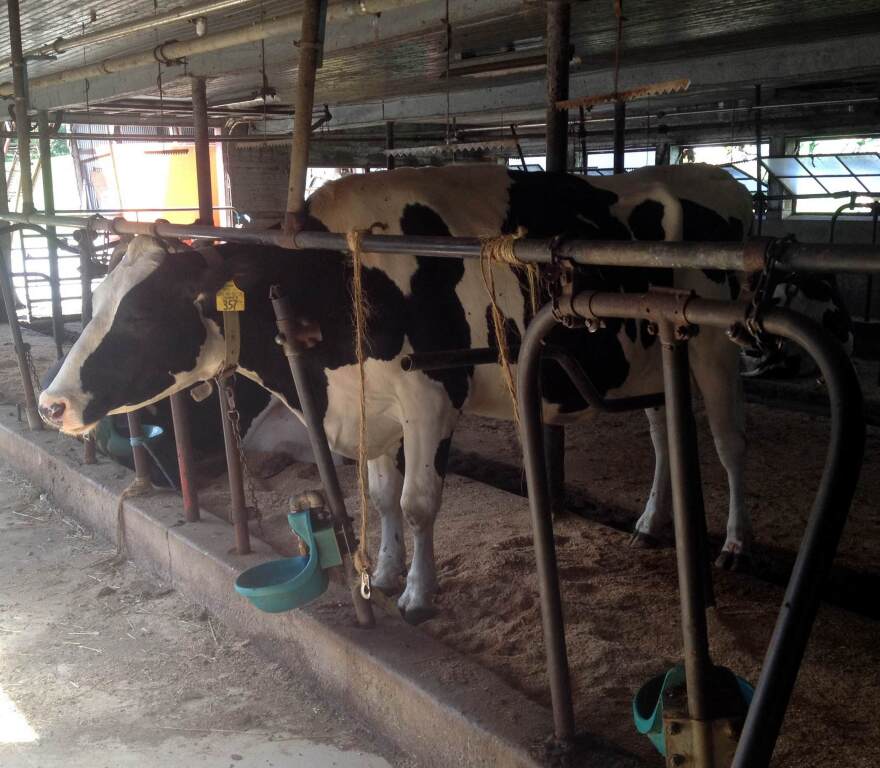There’s a crisis facing New Hampshire’s dairy industry.
Nineteen of the state’s 120 wholesale dairy farms have closed this year.
Now, there’s growing concern about what kind of relief – if any – might be available for these farmers and where the industry goes from here.
Commissioner of the state Department of Agriculture Lorraine Merrill joined NHPR's Morning Edition to talk about the issue.
Now, you’re a dairy farmer yourself, so you know all too well the issues here. What’s happening here?
It’s a combination and the cliché is it’s the perfect storm for dairy farmers. Going back to the year 2014, that was actually a good year for dairy farms. It was a modestly profitable year. And since then, things have just gone down the spiral. It’s a combination of global markets and supplies, national markets and supplies, and the local/regional markets and supplies. And making everything so much worse is this extreme to severe drought that we’re experiencing in much of the state.
A lot of southeastern New Hampshire in that extreme category and I know that’s where your farm happens to be. What are farmers telling you across the state that they’ve been seeing this season in particular?
I was at a meeting of dairy farmers hosted by the New Hampshire Farm Bureau’s dairy committee just the other evening with dairy farmers from all over the state. Virtually all of our dairy farms have experienced some degree of dry weather and reduced forage crop harvest, so pasture, hay, haylage, what we call chopped hay, silage. And many have also experienced some real losses in their all-important silage corn crops.
And this is what they use to feed their animals, correct?
That’s exactly right. Those are the crops that are used to feed dairy cattle here in New Hampshire.
So when you talk about a perfect storm, not only are we talking about a severe drought this season, but we’ve had historically low prices combined with high feed costs.
The last two years, as I mentioned, 2014 milk prices were modestly profitable. Since then, the 2016 milk prices so far are averaging nearly 40 percent down from what that 2014 price was. I can assure you that farmers’ costs have not gone down 38 percent or 40 percent in that last year and a half. This amounts to the state’s dairy farmers lost a collective more than $7 million last year in 2015 due to the milk price situation alone. That’s basically losing over $500 per cow. And 2016 prices have been worse than 2015’s were.
What does this mean for consumers in the long run? As we lose these dairy farms, what is it going to mean for people at the store?
At the stores and in the landscape around the state, people have often expressed their desire for a fresh, local milk supply. But they often take it for granted because people don’t associate milk, as available in the supermarkets wherever people might pick up their gallon of milk to bring home, that that is a local and regional product in most cases.
New Hampshire dairy farmers have been producing about a third of the state population’s needs of milk and dairy products. That’s the only food group that the farmers in New Hampshire produce a significant portion of our population’s supply. So that’s the irony. With all the emphasis on local food and local farms, dairy is really the one that’s the engine and that’s the one that’s really threatened right now.
That's the irony. With all the emphasis on local food and local farms, dairy is really the one that's the engine and that's the one that's really threatened right now.
Is this a problem for other New England states?
While there have been some losses of farms in our neighboring New England states, New Hampshire is clearly experiencing more rapid loss. And that’s why we’ve been working with the governor and the legislators. The legislature did establish a milk producers’ emergency relief fund back in 2008, but it has not been funded. And so we are working now through the budget process. The governor’s been very supportive of the department including money in both fiscal years of this next budget, but it’s going to take more work to see that carried through. And also recognizing that right now, there are dairy farms that don’t have enough feed to get their herds through the fall and winter.
That brings up that this is going to take some time here. What kind of emergency relief avenues can farmers pursue now?
That is a critical question. We have been working both with our Congressional delegation and our neighboring states’ departments of agriculture to see if there isn’t more USDA can do in the immediate term. We’re also working with the governor and legislative leaders, trying to find some way to find some emergency through this fall and early winter.
Long term, how drastic a change is this going to be for the state’s agricultural industry and identity?
That’s the big question. Dairy farms are the iconic farms of the landscape that I think everyone imagines when they think of our working landscape. We in the Department of Agriculture have estimated that dairy cattle are probably supporting close to 70 percent of the actively farmed land in the state. Not that the dairy farms own all of that land, but that land is growing crops to feed dairy cattle, other farmers produce a lot of feed that they sell to dairy farms. It’s a very important part of both the economic and the landscape. In the last year, we’ve had these 120 wholesale commercial dairy farms and they have been generating just on milk sales close to a third of the total gross sales of New Hampshire agriculture. So there’s that, and the working landscape. It could really change things drastically. Coming out of this recession, there’s more demand for land for development. So we hope we can that we can stop this trend before it gets accelerating worse.









